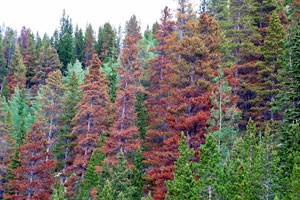
NPS Forest health describes the condition and diversity of trees and other vegetation, as well as the status of important forest processes like nutrient cycling. Healthy forests provide suitable habitat for native animals and plants, purify air and water, and help regulate the climate. Forests also provide valuable recreational opportunities and important natural resources for fuel, lumber, and paper. Monitoring forest health in Rocky Mountain National Park helps resource managers understand the overall condition of the forests, including the prevalence of forest pests and diseases, as well as the impact of air pollution and other stresses.

NPS The Mountain Pine BeetleWhy are there so many brown trees? The Mountain Pine Beetle is one of several common, native insects that challenge western pine forests. Drought conditions, mild winters, dwarf mistletoe infestations, dense late seral mature forest stands, and a lack of wildland fires have contributed to the outbreak. The scale of the current beetle epidemic is unprecedented in historic times, with millions of acres of trees being affected throughout the West from Mexico to British Columbia. Watch Out for Falling Trees!Falling trees are always a hazard when traveling in forested areas.Follow these guidelines to help avoid the risks associated with falling trees.
|
Last updated: September 24, 2024
